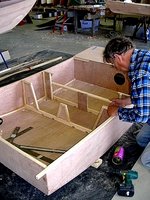
No Story about the DuckFlat Spring School is complete without a bit of a spiel about the first of the Mk2 OZ PDRacers being built. It was only one among the 12 different projects – but, hey, it is MY Design!!! (My other designs can be seen by clicking the links in the left column.)
It is the first one to be built to registration stage from the revised Mk2 Plan. The builder was Rob Johnson, a farmer from Victoria. That’s him starting to put together the first bulkhead (panels acrosst the width of the boat that hold the sides apart. The next picture shows you what a bulkhead looks like when it is fitted between the two side panels. Everything is held together using a cordless reversible drill to drive in gyprock (drywall) screws. They don’t need pilot holes and they pull out afterwards. Modern glued structures don’t need nails or screws.
He has decided to make a big lifestyle change and move from the inland to the coast and wants a boat (or boats) to use. He was allocated the international hull #118 when we registered the boat at PDRacer.com
 Rob told me he had some experience with building things in his youth, but freely admits that he had forgotten almost everything he’d ever known about using woodworking tools. Nonetheless he managed to build both the hull and the mast of the PD Racer in the 10 day class.
Rob told me he had some experience with building things in his youth, but freely admits that he had forgotten almost everything he’d ever known about using woodworking tools. Nonetheless he managed to build both the hull and the mast of the PD Racer in the 10 day class.
He took them home in the back and on the roof of his twin cab ute.
I was very happy with the way it all went together – quite a big improvement over the original two Mk1 boats I built earlier in the year. All that work calculating the true shapes of components and how they fit together seemed to have had positive results – there only needed to be a little bit of adjustment of one of the side tank faces – everything else just dropped in place.
 Also the boat looks neater and stronger than the originals. Some of the changes to the boat (and the plans)
Also the boat looks neater and stronger than the originals. Some of the changes to the boat (and the plans)
1/ to extend the sidetanks a little more forward to they hide part of the floor stiffener – makes the boat look tidier and more integrated
2/ Increase the angle of the side tanks from 12 to 18 degrees. This moves the face of the tank more into the middle of the boat where it can stiffen the bottom more effectively.
3/ Some changes to the mast making procedure to make it much faster – also to suggest that those who have routers should use them.
 4/ A slight change to the hull rocker to reduce the sudden nose up attitude the boat takes when it starts to get onto the plane.
4/ A slight change to the hull rocker to reduce the sudden nose up attitude the boat takes when it starts to get onto the plane.
5/ The mast was beefed up slightly without increasing weight by much. One of the original Mk1 masts had broken and both were a bit bendy. By increasing their outer dimensions without increasing the wall thickness they are much stiffer (about 60%) with a weight increase of around 8%. Of course the sail had to be redesigned to match the new mast bend as they work as a unit.
 All changes worked out well and have been incorporated in the plans.
All changes worked out well and have been incorporated in the plans.
The other thing that has been incorporated in the plans are some of the pictures of Rob building the boat. The sequence of building was changed between the Mk1 and Mk2 boats to make things much simpler and we didn’t have photos for the plans that reflect the new method. Rob allowed us to fill in those gaps nicely – though you can see him grinning that sorta indicates that he would like the photographer (me) to stop taking pictures every 20 minutes!!!
Anyway, it all worked pretty well and the boat is nice and light and feels immensly stiff and strong.
By the way he has christened his boat “Overundersidewaysdown”.
Thanks Rob!!!